brake light Citroen C5 2016 (RD/TD) / 2.G Owner's Manual
[x] Cancel search | Manufacturer: CITROEN, Model Year: 2016, Model line: C5, Model: Citroen C5 2016 (RD/TD) / 2.GPages: 366, PDF Size: 30.93 MB
Page 4 of 366
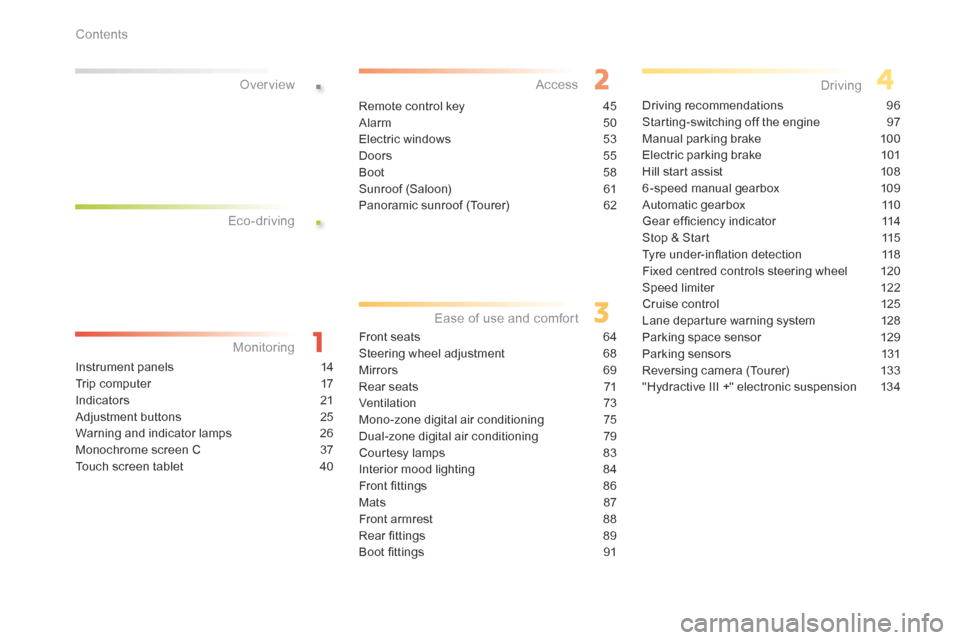
.
.
C5_en_Chap00a_sommaire_ed01-2015
Instrument panels 14
Trip computer 17
Indicators 21
Adjustment buttons 25
Warning and indicator lamps 26
Monochrome screen C 37
Touch screen tablet 40
over view
Front seats 64
Steering wheel adjustment 68
Mirrors 69
Rear seats 71
Ventilation 73
Mono-zone digital air conditioning 75
Dual-zone digital air conditioning 79
Courtesy lamps 83
Interior mood lighting 84
Front fittings 86
Mats 87
Front armrest 88
Rear fittings 89
Boot fittings 91Driving recommendations
96
Starting-switching off the engine 97
Manual parking brake 100
Electric parking brake 101
Hill start assist 108
6 -speed manual gearbox 109
Automatic gearbox 110
Gear ef ficiency indicator 114
Stop & Start 115
Tyre under-inflation detection 118
Fixed centred controls steering wheel 120
Speed limiter 122
Cruise control 125
Lane departure warning system 128
Parking space sensor 129
Parking sensors 131
Reversing camera (Tourer) 133
"Hydractive III +" electronic suspension 134
Eco-driving
Monitoring access
Ease of use and comfort Driving
Remote control key
45
Alarm 50
Electric windows 53
d oors 55
Boot 58
Sunroof (Saloon) 61
Panoramic sunroof (Tourer) 62
Contents
Page 6 of 366
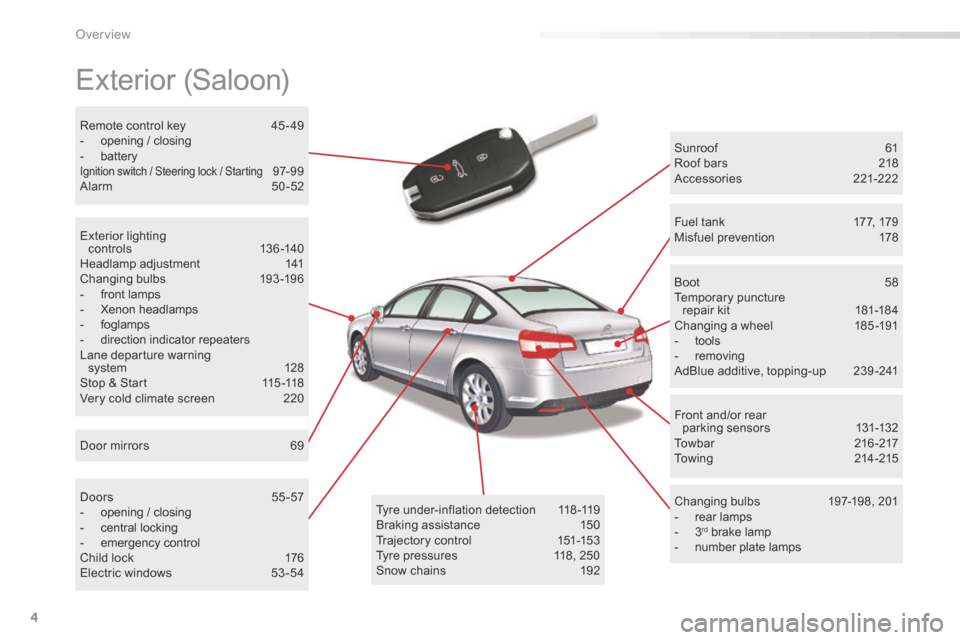
4
C5_en_Chap00b_vue-ensemble_ed01-2015
Exterior (Saloon)
Sunroof 61
Roof bars 218
a ccessories 221-222
Changing bulbs 197-198, 201
- rear lamps
- 3
rd brake lamp
- number plate lamps
Boot
58
Temporary puncture
repair kit 181-184
Changing a wheel 185 -191
- tools
- removing
AdBlue additive, topping-up 239 -241
Tyre under-inflation detection 118 -119
Braking assistance 150
Trajectory control 151-153
Tyre pressures 118, 250
Snow chains 192Fuel tank
177, 179
Misfuel prevention 178
Remote control key
45 - 49
- opening / closing
- battery
Ignition switch / Steering lock / Starting 97- 9 9
Alarm 50-52
Door mirrors 69
Exterior lighting
c o nt r o ls 13 6 -14 0
Headlamp adjustment 141
Changing bulbs 193-196
- front lamps
- Xenon headlamps
- foglamps
- direction indicator repeaters
Lane departure warning system 128
Stop & Start 115 -118
Very cold climate screen 220
Doors 55 -57
- opening / closing
- central locking
- emergency control
Child lock 176
Electric windows 53 -54 Front and/or rear
parking sensors 131-132
Towbar 216 -217
Towing 214 -215
over view
Page 7 of 366
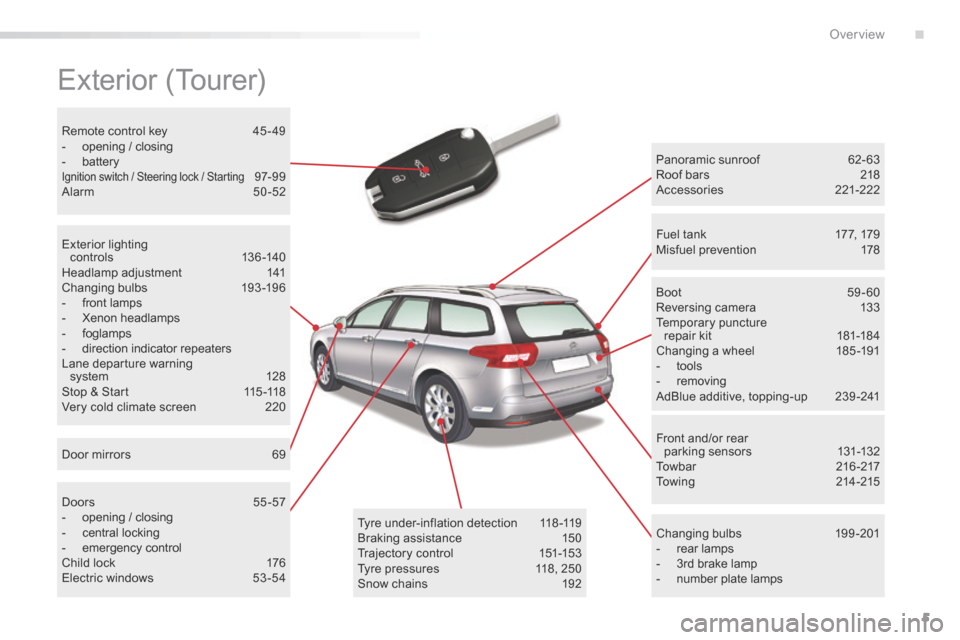
5
C5_en_Chap00b_vue-ensemble_ed01-2015
Exterior (Tourer)
Panoramic sunroof 62- 63
Roof bars 218
a ccessories 221-222
Changing bulbs 199-201
- rear lamps
- 3rd brake lamp
- number plate lamps
Boot
59-60
Reversing camera 133
Temporary puncture
repair kit 181-184
Changing a wheel 185 -191
- tools
- removing
AdBlue additive, topping-up 239 -241
Tyre under-inflation detection 118 -119
Braking assistance 150
Trajectory control 151-153
Tyre pressures 118, 250
Snow chains 192
Remote control key
45 - 49
- opening / closing
- battery
Ignition switch / Steering lock / Starting 97- 9 9
Alarm 50-52
Fuel tank 177, 179
Misfuel prevention 178
Door mirrors 69
Exterior lighting
c o nt r o ls 13 6 -14 0
Headlamp adjustment 141
Changing bulbs 193-196
- front lamps
- Xenon headlamps
- foglamps
- direction indicator repeaters
Lane departure warning system 128
Stop & Start 115 -118
Very cold climate screen 220
Doors 55 -57
- opening / closing
- central locking
- emergency control
Child lock 176
Electric windows 53 -54 Front and/or rear
parking sensors 131-132
Towbar 216 -217
Towing 214 -215
.
over view
Page 9 of 366
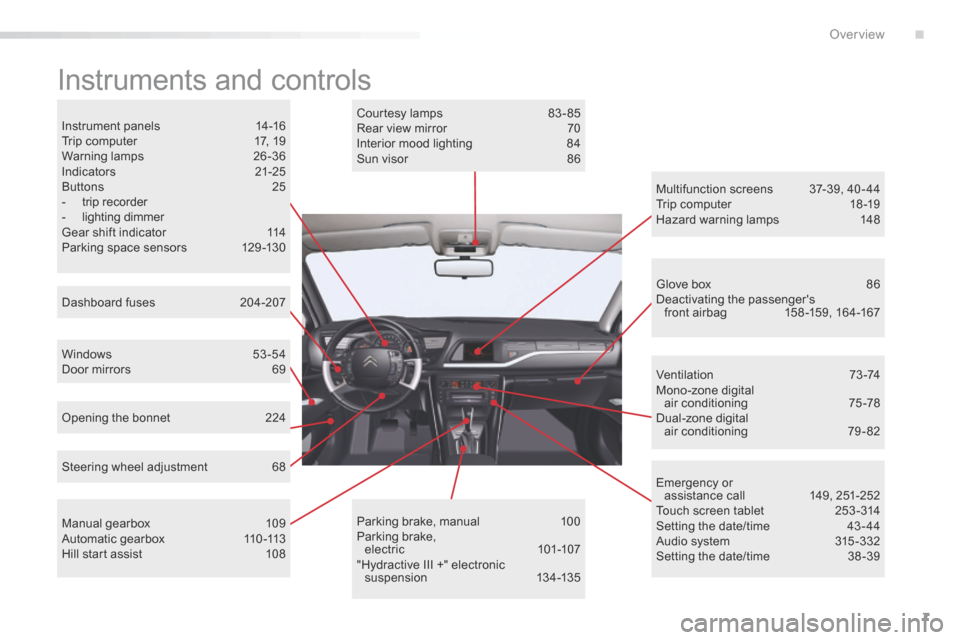
7
C5_en_Chap00b_vue-ensemble_ed01-2015
Instruments and controls
Instrument panels 14-16
Trip computer 17, 19
Warning lamps 26-36
Indicators 21-25
b uttons 25
- trip recorder
- lighting dimmer
Gear shift indicator 114
Parking space sensors 129 -130
Windows 53-54
Door mirrors 69
Opening the bonnet 224
Dashboard fuses
204-207
Manual gearbox 109
Automatic gearbox 110 -113
Hill start assist 108Courtesy lamps
83 - 85
Rear view mirror 70
Interior mood lighting 84
Sun visor 86
Parking brake, manual 100
Parking brake, electric 101-107
"Hydractive III +" electronic suspension 13 4 -13 5 Multifunction screens
37-39, 40 - 44
Trip computer 18 -19
Hazard warning lamps 148
Ventilation 73-74
Mono-zone digital air conditioning 75 -78
Dual-zone digital
air conditioning 79 - 82
Emergency or assistance call 149, 251-252
Touch screen tablet 253 -314
Setting the date/time 43 - 44
Audio system 315 -332
Setting the date/time 38 -39
Steering wheel adjustment
68 Glove box
86
Deactivating the passenger's
front airbag 158 -159, 164-167
.
over view
Page 14 of 366
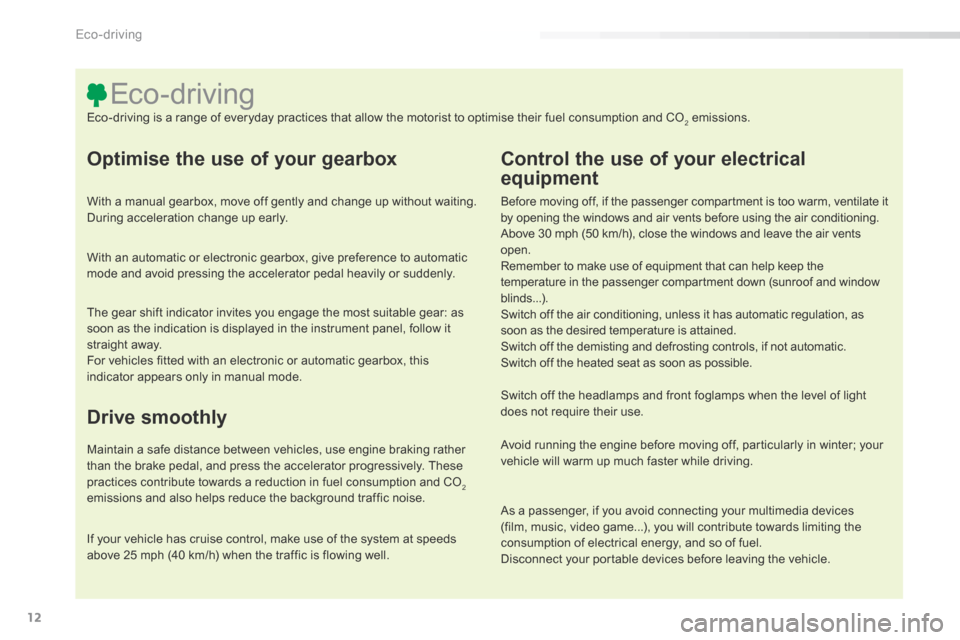
12
C5_en_Chap00c_eco-conduite_ed01-2015
Optimise the use of your gearbox
With a manual gearbox, move off gently and change up without waiting.
During acceleration change up early.
With an automatic or electronic gearbox, give preference to automatic
mode and avoid pressing the accelerator pedal heavily or suddenly.
Control the use of your electrical
equipment
Before moving off, if the passenger compartment is too warm, ventilate it
by opening the windows and air vents before using the air conditioning.
Above 30 mph (50 km/h), close the windows and leave the air vents
open.
Remember to make use of equipment that can help keep the
temperature in the passenger compartment down (sunroof and window
blinds...).
Switch off the air conditioning, unless it has automatic regulation, as
soon as the desired temperature is attained.
Switch off the demisting and defrosting controls, if not automatic.
Switch off the heated seat as soon as possible.
Switch off the headlamps and front foglamps when the level of light
does not require their use.
Avoid running the engine before moving off, particularly in winter; your
vehicle will warm up much faster while driving.
As a passenger, if you avoid connecting your multimedia devices
(film, music, video game...), you will contribute towards limiting the
consumption of electrical energy, and so of fuel.
Disconnect your portable devices before leaving the vehicle.
Eco-driving
Eco-driving is a range of everyday practices that allow the motorist to optimise their fuel consumption and CO2 emissions.
The gear shift indicator invites you engage the most suitable gear: as
soon as the indication is displayed in the instrument panel, follow it
straight away.
For vehicles fitted with an electronic or automatic gearbox, this
indicator appears only in manual mode.
Drive smoothly
Maintain a safe distance between vehicles, use engine braking rather
than the brake pedal, and press the accelerator progressively. These
practices contribute towards a reduction in fuel consumption and CO
2
emissions and also helps reduce the background traffic noise.
If your vehicle has cruise control, make use of the system at speeds
above 25 mph (40 km/h) when the traffic is flowing well.
Eco-driving
Page 18 of 366
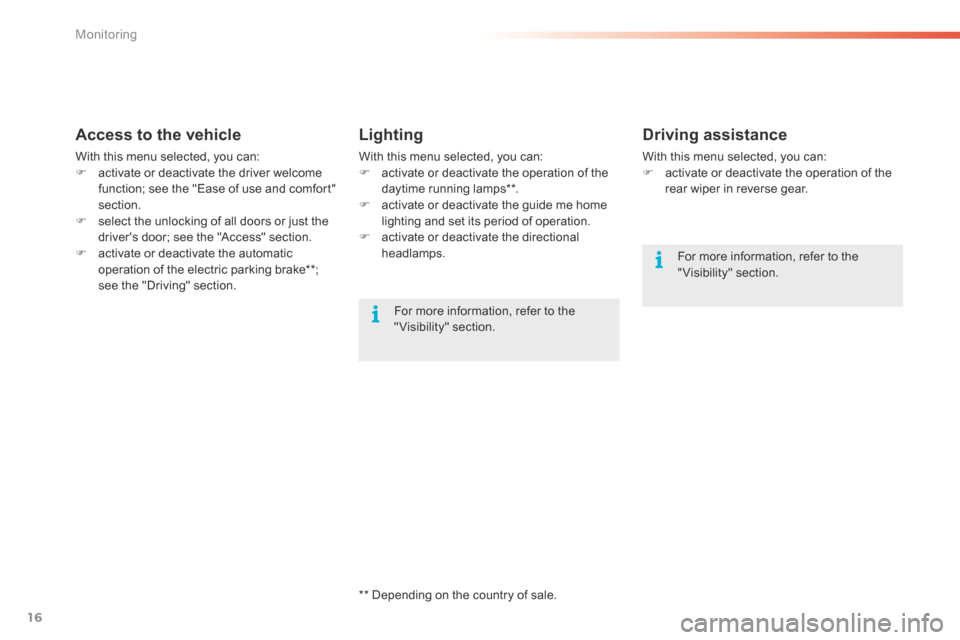
16
C5_en_Chap01_controle-de-marche_ed01-2015
Access to the vehicle
With this menu selected, you can:
F activate or deactivate the driver welcome
function; see the "Ease of use and comfort"
section.
F select the unlocking of all doors or just the
driver's door; see the "Access" section.
F activate or deactivate the automatic
operation of the electric parking brake**;
see the "Driving" section.
Lighting
With this menu selected, you can:
F activate or deactivate the operation of the
daytime running lamps**.
F activate or deactivate the guide me home
lighting and set its period of operation.
F activate or deactivate the directional
headlamps.
Driving assistance
With this menu selected, you can:
F activate or deactivate the operation of the
rear wiper in reverse gear.
For more information, refer to the
"Visibility" section. For more information, refer to the
"Visibility" section.
** Depending on the country of sale.
Monitoring
Page 37 of 366
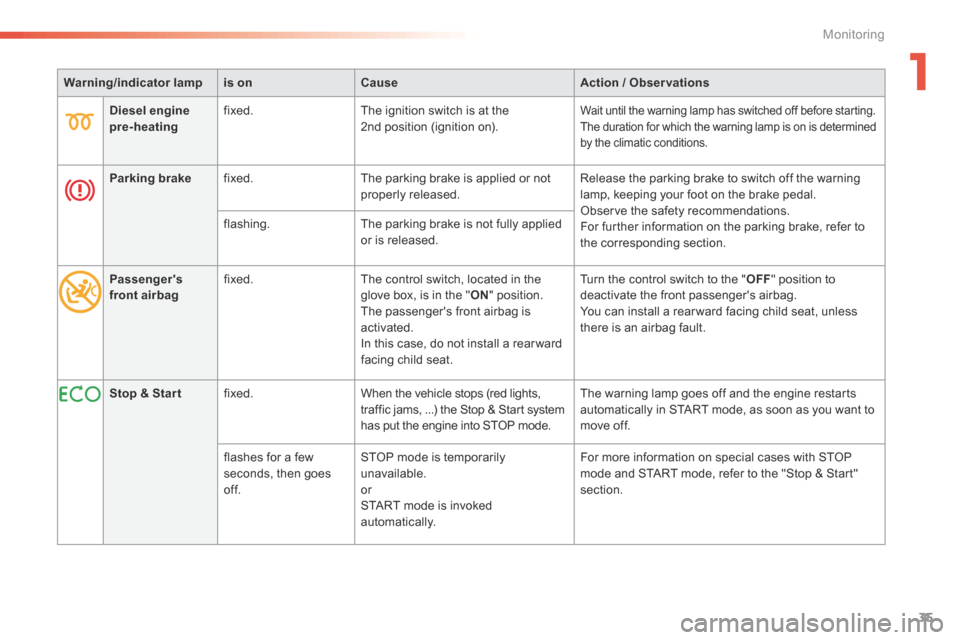
35
C5_en_Chap01_controle-de-marche_ed01-2015
Warning/indicator lampis on Cause Action / Observations
Diesel engine
pre-heating fixed.
The ignition switch is at the
2nd position (ignition on).
Wait until the warning lamp has switched off before starting.
The duration for which the warning lamp is on is determined
by the climatic conditions.
Parking brakefixed. The parking brake is applied or not
properly released. Release the parking brake to switch off the warning
lamp, keeping your foot on the brake pedal.
Observe the safety recommendations.
For further information on the parking brake, refer to
the corresponding section.
flashing.
The parking brake is not fully applied
or is released.
Passenger's
front airbag fixed.
The control switch, located in the
glove box, is in the "ON" position.
The passenger's front airbag is
activated.
In this case, do not install a rear ward
facing child seat. Turn the control switch to the "
OFF" position to
deactivate the front passenger's airbag.
You can install a rear ward facing child seat, unless
there is an airbag fault.
Stop & Star t fixed. When the vehicle stops (red lights,
traffic jams, ...) the Stop & Start system
has put the engine into STOP mode. The warning lamp goes off and the engine restarts
automatically in START mode, as soon as you want to
move off.
flashes for a few
seconds, then goes
of f. STOP mode is temporarily
unavailable.
or
START mode is invoked
automatically. For more information on special cases with STOP
mode and START mode, refer to the "Stop & Start"
section.
1
Monitoring
Page 44 of 366
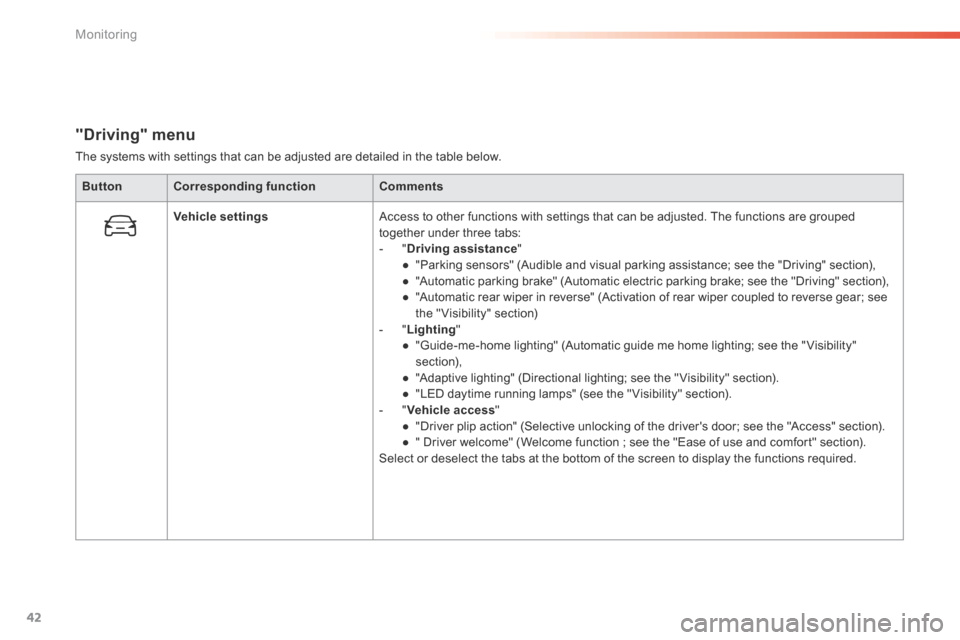
42
C5_en_Chap01_controle-de-marche_ed01-2015
"Driving" menu
The systems with settings that can be adjusted are detailed in the table below.Button Corresponding function Comments
Vehicle settings Access to other functions with settings that can be adjusted. The functions are grouped
together under three tabs:
- "Driving assistance "
● "Parking sensors" (Audible and visual parking assistance; see the "Driving" section),
● "Automatic parking brake" (Automatic electric parking brake; see the "Driving" section),
● "Automatic rear wiper in reverse" (Activation of rear wiper coupled to reverse gear; see
the " Visibility" section)
- " Lighting "
● "Guide-me-home lighting" (Automatic guide me home lighting; see the " Visibility"
section),
● "Adaptive lighting" (Directional lighting; see the " Visibility" section).
● "LED daytime running lamps" (see the " Visibility" section).
- " Vehicle access "
● "Driver plip action" (Selective unlocking of the driver's door; see the "Access" section).
● " Driver welcome" (Welcome function ; see the "Ease of use and comfort" section).
Select or deselect the tabs at the bottom of the screen to display the functions required.
Monitoring
Page 98 of 366
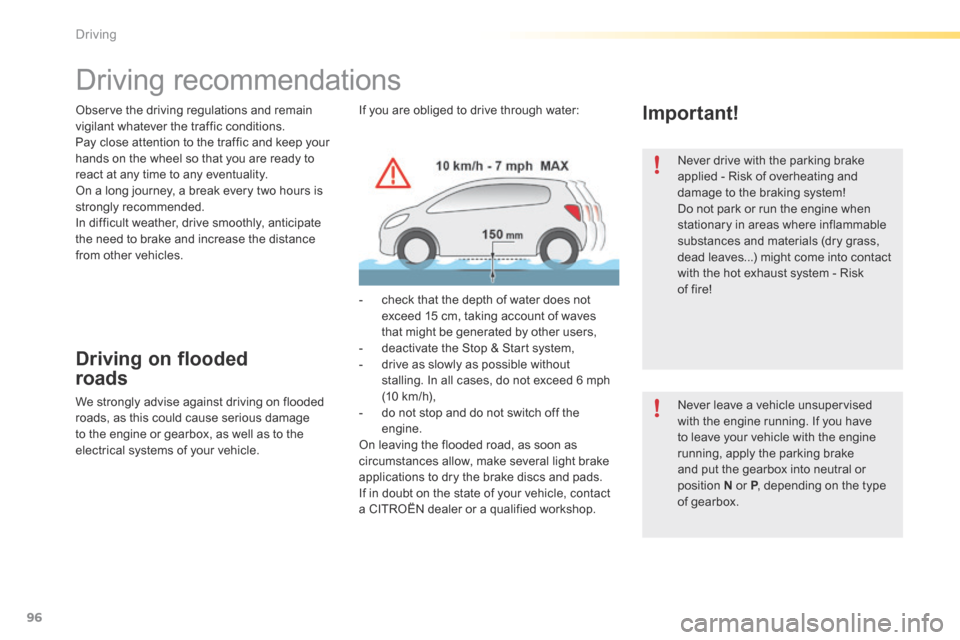
96
C5_en_Chap04_conduite_ed01-2015
Observe the driving regulations and remain
vigilant whatever the traffic conditions.
Pay close attention to the traffic and keep your
hands on the wheel so that you are ready to
react at any time to any eventuality.
On a long journey, a break every two hours is
strongly recommended.
In difficult weather, drive smoothly, anticipate
the need to brake and increase the distance
from other vehicles.
Driving on flooded
roads
We strongly advise against driving on flooded
roads, as this could cause serious damage
to the engine or gearbox, as well as to the
electrical systems of your vehicle.
Driving recommendations
Important!
Never drive with the parking brake
applied - Risk of overheating and
damage to the braking system!
Do not park or run the engine when
stationary in areas where inflammable
substances and materials (dry grass,
dead leaves...) might come into contact
with the hot exhaust system - Risk
of fire!
n ever leave a vehicle unsupervised
with the engine running. If you have
to leave your vehicle with the engine
running, apply the parking brake
and put the gearbox into neutral or
position N or P, depending on the type
of gearbox.
If you are obliged to drive through water:
-
check that the depth of water does not
exceed 15 cm, taking account of waves
that might be generated by other users,
- deactivate the Stop & Start system,
- drive as slowly as possible without
stalling. In all cases, do not exceed 6 mph
(10 km/h),
- do not stop and do not switch off the
engine.
On leaving the flooded road, as soon as
circumstances allow, make several light brake
applications to dry the brake discs and pads.
If in doubt on the state of your vehicle, contact
a CITROËN dealer or a qualified workshop.
driving
Page 117 of 366
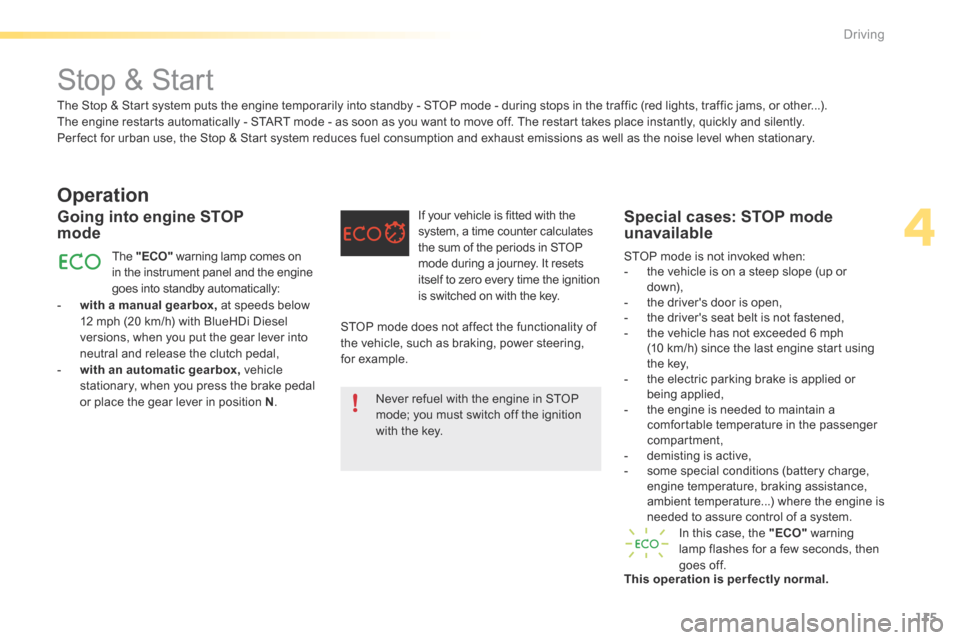
115
C5_en_Chap04_conduite_ed01-2015
Stop & Start
Operation
- with a manual gearbox, at speeds below
12 mph (20 km/h) with BlueHDi Diesel
versions, when you put the gear lever into
neutral and release the clutch pedal,
- with an automatic gearbox, vehicle
stationary, when you press the brake pedal
or place the gear lever in position N .
Going into engine STOP
mode
The "ECO" warning lamp comes on
in the instrument panel and the engine
goes into standby automatically: If your vehicle is fitted with the
system, a time counter calculates
the sum of the periods in STOP
mode during a journey. It resets
itself to zero every time the ignition
is switched on with the key.
Special cases: STOP mode
unavailable
In this case, the "ECO"
warning
lamp flashes for a few seconds, then
goes off.
This operation is perfectly normal. STOP mode is not invoked when:
- the vehicle is on a steep slope (up or
d ow n),
- the driver's door is open,
- the driver's seat belt is not fastened,
- the vehicle has not exceeded 6 mph
(10 km/h) since the last engine start using
the key,
- the electric parking brake is applied or
being applied,
- the engine is needed to maintain a
comfortable temperature in the passenger
compartment,
- demisting is active,
- some special conditions (battery charge,
engine temperature, braking assistance,
ambient temperature...) where the engine is
needed to assure control of a system.
The Stop & Start system puts the engine temporarily into standby - STOP mode - during stops in the traffic (red lights, traffic jams, or other...).
The engine restarts automatically - START mode - as soon as you want to move off. The restart takes place instantly, quickly and silently.
Per fect for urban use, the Stop & Start system reduces fuel consumption and exhaust emissions as well as the noise level when stationary.
STOP mode does not affect the functionality of
the vehicle, such as braking, power steering,
for example.Never refuel with the engine in STOP
mode; you must switch off the ignition
with the key.
4
driving